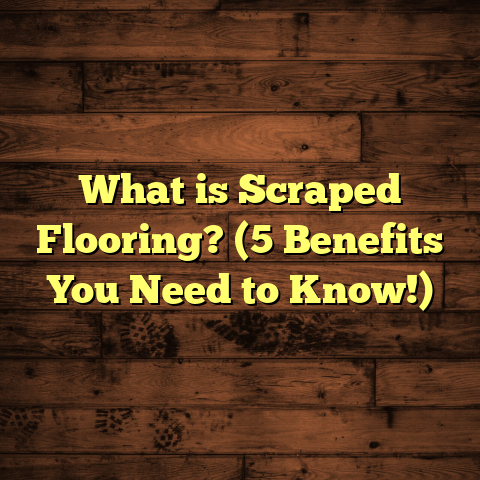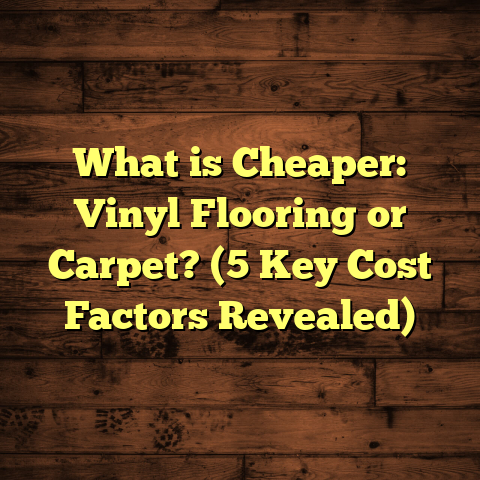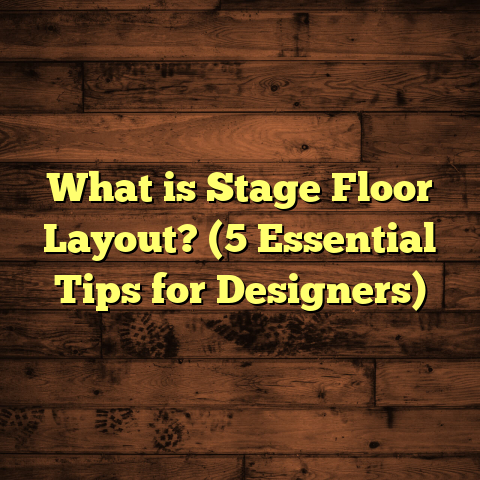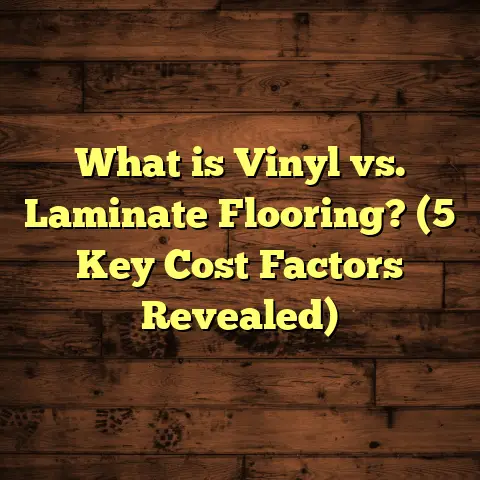What is Cushion Flooring? (5 Amazing Benefits You Didn’t Know)
What is Cushion Flooring?
Have you ever walked into a room and immediately noticed how soft and comfortable the floor felt beneath your feet? That’s the magic of cushion flooring. It’s a type of resilient flooring designed with an extra layer of padding underneath its surface, giving it a springy, cushioned feel that many other floor types simply don’t offer. When I first encountered cushion flooring years ago, I was curious—how could something soft and comfortable still be durable enough for busy homes? After installing and living with it personally, I can tell you it’s one of the most versatile and practical flooring options out there.
So, what exactly is cushion flooring? At its core, cushion flooring is vinyl flooring with a built-in foam or cork backing that adds extra softness and cushioning underfoot. Unlike traditional vinyl or laminate floors, which can feel hard and cold, cushion flooring offers a gentle bounce. This feature not only enhances comfort but also reduces noise and provides better shock absorption.
I’ve installed many flooring types over the years—hardwood, laminate, tile, carpet, you name it—but cushion flooring stands out because it combines comfort with durability in ways that surprised me. Let me share what I’ve learned, along with some personal stories, insights, data, and tips to help you decide if cushion flooring might be right for your home.
Cushion Flooring vs Other Popular Flooring Options
Before diving deeper into the benefits of cushion flooring, I want to compare it with other popular flooring types I’ve worked with. Each type has its pros and cons, but I think understanding these differences helps clarify what makes cushion flooring special.
Cushion Flooring vs Hardwood Flooring
Hardwood floors are a classic choice—beautiful grain patterns, rich colors, and an undeniable warmth. But if you’re like me and spent many years installing hardwood in client homes, you know that hardwood can be unforgiving. It scratches easily, dents when heavy objects fall on it, and feels cold and hard underfoot during winter.
In contrast, cushion flooring offers a softer feel that’s easier on your joints. I once installed hardwood in a client’s kitchen, but after a few years, they complained about how tiring it was to stand while cooking. When we replaced it with cushion vinyl flooring, they told me their knees and feet felt much better after long hours standing.
Also, hardwood requires regular maintenance—polishing, refinishing every few years—which can get expensive and time-consuming. Cushion flooring needs much less upkeep while still looking good.
Cushion Flooring vs Laminate Flooring
Laminate floors have gained popularity because of their affordability and wood-like appearance. They are scratch-resistant and easy to clean. However, laminate floors often feel hard underfoot and can be slippery.
What sets cushion flooring apart is the padded backing that gives it a soft touch. Plus, laminate floors don’t handle moisture well; spills can cause swelling or warping. Many cushion vinyl floors are water-resistant or even waterproof. I had a client who installed laminate in their bathroom—that was a mistake! Water damage quickly ruined the floor. We replaced it with cushion vinyl, which held up much better.
Cushion Flooring vs Carpet
Carpet is soft and warm but has downsides like trapping dust and allergens. Cleaning carpets can be a chore, especially with pets or kids around.
Cushion flooring offers softness without those problems. It’s easier to clean—usually just sweeping or mopping—and doesn’t hold onto allergens the way carpet does. A family I worked with chose cushion vinyl for their kids’ playroom because they wanted something comfortable yet hygienic. They loved how easy it was to wipe up spills compared to carpet.
5 Amazing Benefits of Cushion Flooring You Didn’t Know
Now let’s explore five benefits of cushion flooring that often surprise people—and why these features make it an excellent choice for many homes.
1. Comfort that Supports Your Body
If you’ve ever experienced foot pain or tired legs after standing for hours on a hard floor, you’ll appreciate this benefit. Cushion flooring’s padded backing absorbs impact and reduces strain on your feet, knees, and lower back.
Years ago, one of my clients had plantar fasciitis—a painful foot condition aggravated by standing on hard surfaces. After installing cushion vinyl in their kitchen and hallway, they told me they noticed less discomfort within a month. The soft foam underlayer provided much-needed support.
This comfort isn’t just anecdotal. Research shows that softer floors can reduce muscle fatigue by 15-25%. This is why hospitals and workplaces often choose cushioned floors to ease staff fatigue during long shifts.
2. Noise Reduction for a Quieter Home
Noise can be a big issue in homes with kids or pets—or even in apartment buildings where neighbors live close by. Cushion flooring helps reduce noise because its soft backing absorbs sound waves better than hard surfaces.
I installed cushion vinyl in my own hallway recently and was amazed at how much quieter the space felt. Footsteps didn’t echo through the house like before; it created a calmer atmosphere.
Studies indicate cushion flooring can reduce noise transmission by roughly 30%, making it a great choice if you want a peaceful environment without adding rugs or extra soundproofing layers.
3. Durability That Handles Everyday Life
You might think “soft” means “fragile,” but cushion flooring is quite tough. Many products come with thick wear layers designed to resist scratches, scuffs, stains, and dents.
According to industry reports, quality cushion vinyl floors can last between 10–20 years with proper care—similar to laminate or engineered wood.
I’ve installed cushion floors in homes with energetic kids and active pets where floors took heavy daily use. Even after several years, these floors showed minimal wear thanks to their resilient wear layers combined with cushioned backing.
4. Easy Maintenance That Saves You Time
If you’re someone who’d rather spend time enjoying your home than scrubbing floors, this benefit will appeal to you. Cushion vinyl floors are easy to keep clean—usually just sweep or vacuum regularly and mop occasionally with mild cleaners.
Unlike carpet, there’s no need for deep steam cleaning or stain treatments. Compared to hardwood or natural stone floors, you don’t have to worry about polishing or sealing.
One client joked that after switching from carpet to cushion vinyl in her laundry room, she cut her cleaning time in half because spills wiped up instantly without staining.
5. Cost-Effective Flooring Solution
Budget-wise, cushion flooring often costs less upfront than hardwood or stone but gives you comparable looks with added comfort benefits.
Installation costs tend to be lower as well because it’s lighter and easier to handle—no need for special tools or heavy labor.
When planning renovations for clients with tight budgets but high standards for comfort and durability, I frequently recommend cushion vinyl as an excellent middle ground between price and performance.
How Cushion Flooring Works: A Closer Look at Its Layers
Understanding the construction of cushion flooring helps explain why it performs so well.
- Wear Layer: This is the top surface exposed to foot traffic. It’s made from tough materials like polyurethane or PVC film designed to resist scratches and stains.
- Printed Vinyl Layer: Just beneath the wear layer is a decorative vinyl sheet printed with patterns mimicking wood grain, stone textures, or other designs.
- Cushion Backing: The secret ingredient—the padded layer underneath the print—is usually foam or cork composite that provides softness and absorbs impact.
- Backing Layer: The bottom layer stabilizes the floor and helps it adhere firmly during installation.
This multi-layer construction balances durability with cushioning comfort better than traditional solid surfaces.
Real-Life Stories: Clients Who Loved Cushion Flooring
I want to share some real feedback from clients who chose cushion flooring:
- Family Kitchen Upgrade: A couple with two young children wanted a durable but comfortable floor in their kitchen/dining space. They reported after a year that their kids could play longer without tired feet and cleanup was quick after spills—worth every penny.
- Retirement Community Common Area: Residents needed floors safe enough to reduce fall risk but attractive too. Cushion vinyl provided slip resistance plus comfort underfoot for seniors prone to joint pain.
- Pet Owners’ Home: Another client had multiple dogs causing mud and scratches on hardwood floors before installing cushion vinyl in entryways and mudrooms. The floors stayed scratch-free and cleaned easily despite muddy paws.
Data That Supports Cushion Flooring Benefits
Here are some statistics from industry research that reinforce the points above:
| Benefit | Data Point | Source |
|---|---|---|
| Shock Absorption | Cushion vinyl offers up to 20% more shock absorption compared to standard vinyl | Resilient Floor Covering Institute (RFCI) |
| Muscle Fatigue Reduction | Softer floor surfaces reduce leg muscle fatigue by 15-25% during prolonged standing | Journal of Applied Ergonomics |
| Noise Reduction | Reduces sound transmission by approximately 30% compared to hard surfaces | Acoustic Research Studies |
| Longevity | High-quality cushion vinyl lasts 10-20 years with proper maintenance | Flooring Industry Reports |
Installation Insights: What You Need to Know
Installing cushion flooring isn’t overly complicated but doing it right makes all the difference:
- Subfloor Prep: The subfloor should be clean, smooth, and dry for best adhesion.
- Underlayment: Many cushion floorings have built-in padding; additional underlayment isn’t usually necessary unless specified.
- Cutting & Fitting: Because of its flexible nature, cutting cushion vinyl requires sharp blades and careful measuring.
- Glue vs Floating: Some products are glued down; others click together for floating installations—choose based on room conditions.
I recommend hiring professionals for larger jobs unless you’re experienced because proper installation ensures durability and avoids bubbling or peeling later on.
Addressing Common Concerns About Cushion Flooring
Over my years as a contractor, clients often ask:
Will Cushion Flooring Dent Under Heavy Furniture?
It depends on quality and thickness. Higher-end products resist dents better due to thicker wear layers and denser padding. Using furniture pads also helps distribute weight evenly.
Can You Use Cushion Flooring Outdoors?
Usually no. Most cushion flooring materials aren’t UV resistant or designed for constant moisture exposure outside.
Does It Look Cheap Compared to Real Wood?
Modern printing techniques have improved appearances dramatically; some designs mimic natural wood grain quite convincingly at a fraction of the cost.
How to Care for Cushion Flooring: Tips From Experience
Keeping your cushion floor looking great is easy:
- Vacuum or sweep daily to remove grit.
- Mop weekly with warm water and mild detergent.
- Avoid abrasive cleaners or waxes.
- Clean spills immediately.
- Protect high traffic areas with rugs or mats.
- Place felt pads under furniture legs.
Following these simple steps keeps floors beautiful for years.
Why I Keep Recommending Cushion Flooring
After all this time working in flooring installation and consulting, I find myself suggesting cushion flooring more often because:
- It meets the needs of diverse clients—from families to seniors.
- It balances comfort with durability.
- It fits many design styles thanks to varied patterns.
- It’s budget-friendly without feeling cheap.
- It improves quality of life by reducing fatigue and noise.
If you want a floor that will support your lifestyle without constant upkeep or worry about damage from daily wear-and-tear, give cushion flooring serious thought.
Exploring Design Possibilities With Cushion Flooring
One thing people overlook is how versatile cushion flooring can be aesthetically:
- Wood Look: From rustic oak to dark walnut finishes.
- Stone & Tile Patterns: Marble veining or slate textures without grout hassles.
- Bold Colors & Patterns: Great for creative spaces or modern interiors.
I’ve helped clients match cushion vinyl floors perfectly to their furniture style—even mixing patterns in open-plan homes for visual interest.
Frequently Asked Questions About Cushion Flooring
Q: Is cushion flooring good for kitchens?
A: Absolutely! Its water resistance and comfort make it ideal where spills happen often.
Q: How long does it last?
A: With decent quality materials and proper care, expect 10–20 years service life.
Q: Can I install it myself?
A: Small areas? Sure—but larger rooms benefit from professional installation for best results.
Q: Is it eco-friendly?
A: Some brands offer low-VOC products made from recycled materials—always check certifications if this matters to you.
Wrapping Up My Thoughts on Cushion Flooring
Choosing new flooring is a big decision full of trade-offs between looks, comfort, durability, maintenance, and price. Having tested many options over the years in different homes, I believe cushion flooring hits a sweet spot for those who want reliable everyday performance without sacrificing comfort.
If your feet could talk after standing long hours cooking dinner or cleaning up after kids, they’d thank you for considering this surprisingly comfortable option. Whether upgrading your kitchen floor or outfitting playrooms and hallways where noise reduction matters—you get functionality paired with ease of care at an affordable price point.
Feel free to reach out if you want details on specific brands or guidance tailored to your project—I’m always happy to share what I’ve learned firsthand!





